Welcome to the ultimate guide to lupin flour – the best low-carb and high protein flour!
In this blog post, you will learn everything you need to know about lupin flour, from what it is and how it’s made to its nutritional and health benefits and how you can use it in recipes.
If you’re someone who follows a keto or gluten-free diet, has food sensitivities, or simply enjoys exploring new and nutritious ingredients, then lupin flour might be your next culinary discovery.
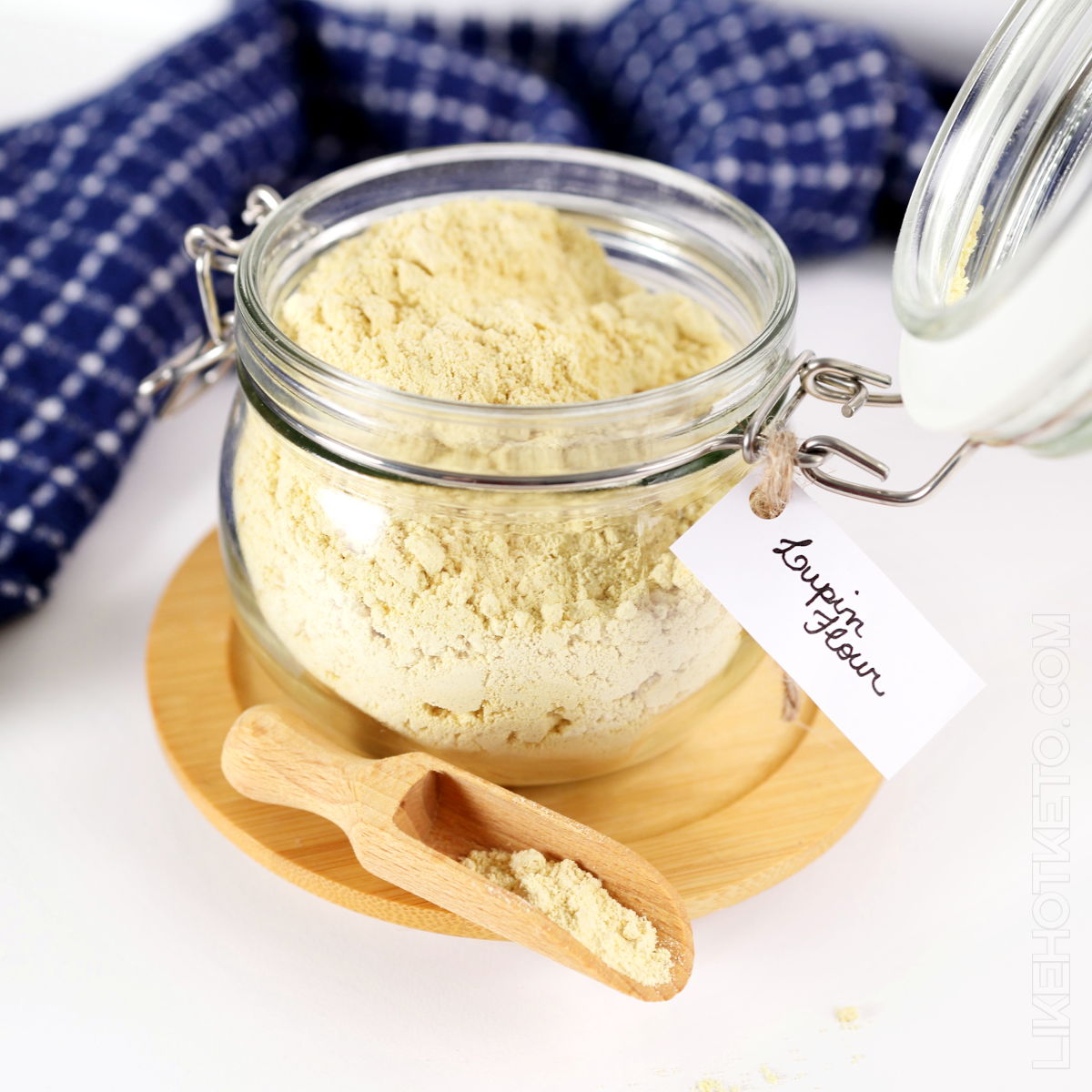
Do you have a specific question about lupin flour in mind? To quickly find the answer you need, click the on topic on the handy table of contents below:
What is Lupin Flour?
Lupin flour is made from sweet lupini beans, a legume from the same family as peanuts. It’s one of the highest sources of natural, unprocessed protein.
Lupin flour is naturally gluten-free, low in carbohydrates and fat, and it has a very high fiber content.
It contains insignificant amounts of anti-nutrients, especially when compared to almond flour. Which makes lupin flour a better keto alternative if you are seeking to reduce the ingestion of phytates or lectins.
All lupin’s health benefits aren’t enough, though, if we can’t use it in keto and low-carb baking. The amazing news: lupin is probably the best keto friendly baking flour in existence!
What does lupin flour taste like?
Lupin flour tastes has a slightly nutty flavor. When mixed with the liquid ingredients in a recipe, lupin flour releases an earthy aroma, reminiscent of chick peas or wet grass, but the smell goes away during cooking.
Is lupin flour bitter?
Lupin flour can have a slightly bitter taste, but the bitterness can vary depending on the brand and type of lupin flour. Some people find that the bitterness is not noticeable, while others find it to be too strong.
If you find yourself stuck with a particularly bitter package of lupin flour, you can try the following methods to make lupin flour less bitter:
- Mix with other flours: Combining lupin flour with other flours, such as almond flour or coconut flour, can help mellow out the bitterness and create a more balanced flavor.
- Acidic Ingredients: Adding acidic ingredients, such as lemon juice or vinegar, to recipes that include lupin flour can help neutralize bitterness.
- Balance with sweetness: To counteract bitterness in sweet recipes, consider enhancing the sweetness by adding a bit more sweeteners or incorporating sweet-tasting ingredients such as chocolate or fruit.
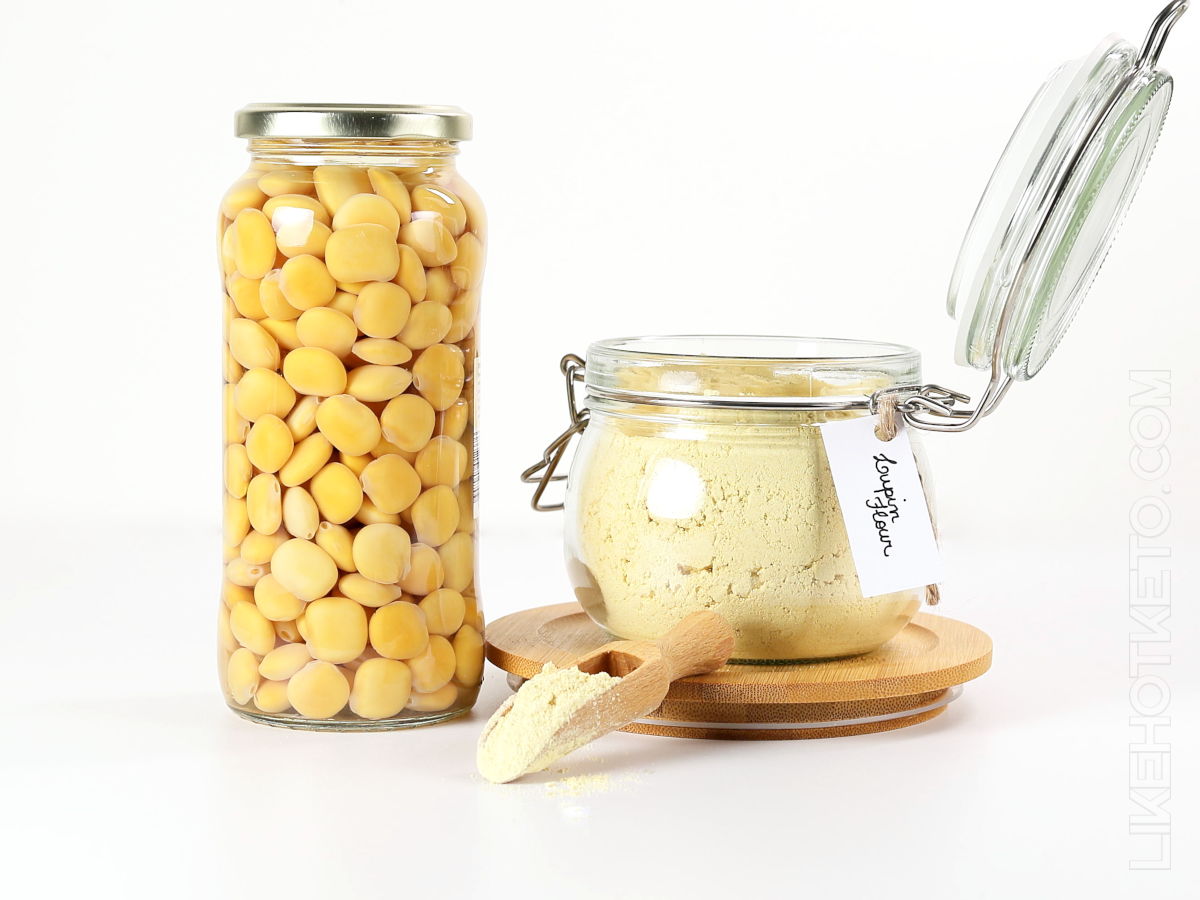
What color is it?
Lupin flour is typically a light yellow color, ranging from ivory to bright yellow with green tones.
This yellow color in lupin flour comes from carotenoids like beta carotene and zeaxanthin, which are antioxidants present in lupin beans.
The color of the flour can vary depending on the type of lupin beans used and the processing method. Some lupin flours may be slightly darker, while others may be lighter.
The color of lupin flour is not a good indicator of its quality. However, if the flour is a very dark color, it may have been roasted, which can give it a stronger flavor.
If you are adding lupin flour to recipes in substitution for white flours (like all-purpose flour or coconut flour), expect your baked goods to be a bit tan in color, with a subtle yellowish tint.
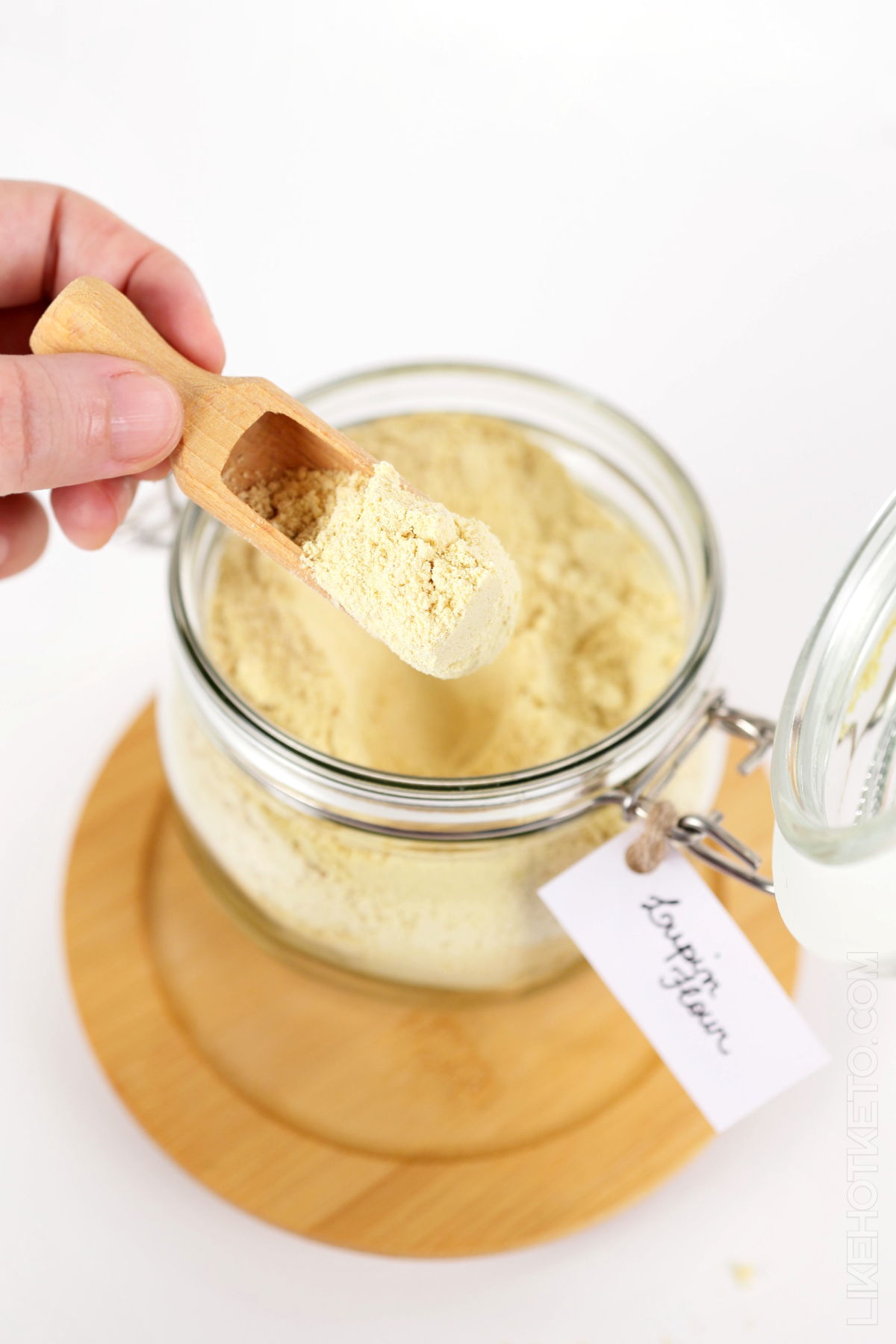
Is lupin flour gluten free?
Yes, lupin flour is gluten-free. Gluten is a protein found in wheat, barley, rye, and their derivatives. As lupin flour is made from ground lupin beans, which are legumes and not related to wheat or other gluten-containing grains, it does not contain gluten.
Because of its gluten-free nature, lupin flour is a suitable alternative for individuals with gluten sensitivities, celiac disease, or those following a gluten-free diet.
It can be used in various gluten-free recipes, including baking, cooking, and as a thickening agent in sauces and soups.
However, it’s essential to check labels and ensure that there is no cross-contamination with gluten-containing products during processing or packaging.
If you have gluten intolerance or celiac disease, always choose certified gluten-free lupin flour to avoid any potential risks.
Is lupin flour keto?
Yes, lupin flour is considered keto because of the very low carbohydrate content: 1/3 cup of lupin flour contains just 2 net carbs.
Some guidelines for a keto diet that you might see online recommend excluding all legumes, regardless of their carbohydrate content. Which makes no sense, unless you have a legume allergy or food intolerance.
If the amount of carbs is your only reason to avoid legumes, you’ll be glad to know that you can safely eat lupin flour and lupini beans on keto and remain in ketosis.
Health benefits of lupin flour
Lupin flour is gaining popularity as a wholesome and nutritious alternative to traditional flours. Lupin flour is a powerhouse food that offers several health benefits. Here are 8 of them:
1. Lowers blood pressure: Increasing protein and fiber in the diet through the addition of lupin kernel flour may reduce blood pressure and cardiovascular risk, according to this study.
2. Supports gut microbiome: Lupin flour contains high amounts of prebiotic fiber, the kind that provides nourishment for beneficial gut bacteria. A healthy gut microbiome is crucial for proper digestion and overall gut health.
3. Aids weight loss: In a systematic review, scientists found that unintended weight loss occurred in 25% of the studies. This suggests that incorporating lupin into your diet may potentially help to lose weight.
4. Controls blood sugar: Due to its high protein and fiber content, lupin four has the potential to regulate blood sugar levels, supporting support glycemic control.
On top of that, studies show that conglutin gamma, a lupin seed protein, binds insulin in vitro and reduces plasma glucose levels of hyperglycemic rats in levels compared to those of metformin.
More research may lead to the possible use of lupin proteins as a nutraceutical in the control of glycemia.
5. Muscle Recovery: The high-quality protein in lupin flour contains all essential amino acids, making it beneficial for muscle repair and recovery after physical activity.
Athletes and fitness enthusiasts looking for high protein foods can benefit from incorporating lupin into their meals.
6. Anti-inflammatory effects: New research (2023) discovered that β-conglutins, which are proteins present in lupin, have anti-inflammatory and antioxidant capacity.
Lupin’s β-conglutin proteins may help prevent the malignant transformation of healthy cells, offering a functional alternative in the fight against disease-related inflammation.
7. Boosts Immunity: The nutrient-rich composition of lupin flour, including vitamins and minerals, helps support a robust immune system. Regular consumption of lupin-based foods may enhance your body’s ability to fight off infections and illnesses.
8. Bone Health: Lupin flour is a good source of essential minerals like calcium, phosphorus, and magnesium, which play a crucial role in maintaining strong bones. Including lupin-based dishes in your meals can contribute to better bone health.
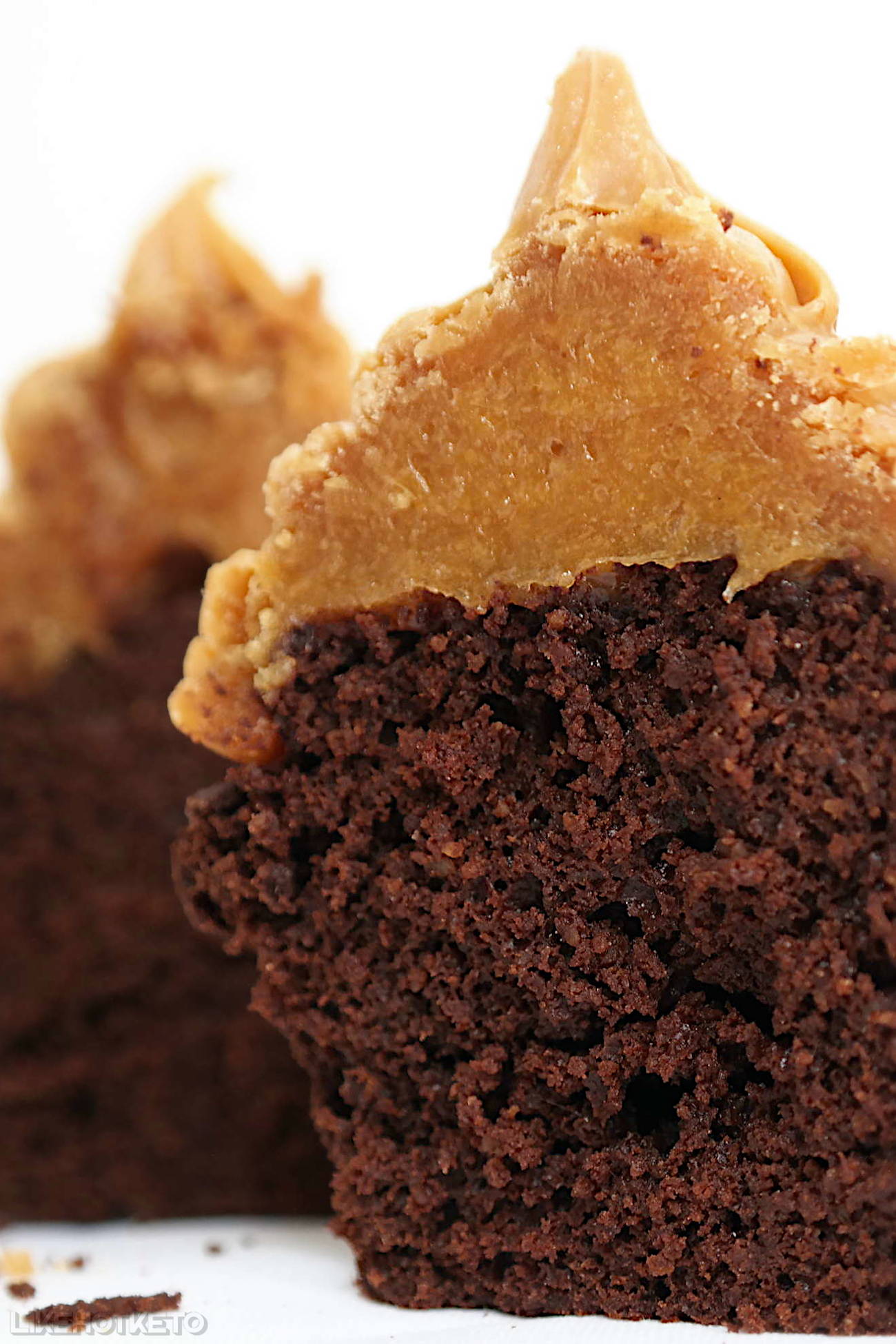
Lupin flour nutrition facts
Lupin flour one of the highest sources of natural, unprocessed protein. It has superior digestibility and bio-availability of essential nutrients, compared to other flours.
Alongside its rich protein content, lupin flour is low in carbohydrates, sugars and starches, making it a favorable option for individuals following low-carb or ketogenic diets.
If you’re concerned with anti-nutrients such as lectins and saponins (gastric irritants) and phytic acid you’ll be glad to know that lupin flour contains negligible levels of these substances.
Below is a table with the calorie and macronutrient breakdown of lupin flour. Please note that the exact nutritional values may vary based on the brand and processing method.
| Nutrients in Lupin Flour | 3.5 oz (100 g) | 1/3 cup (33 g) |
|---|---|---|
| Energy (Calories) | 333 kcal | 110 kcal |
| Fat | 6.06 g | 2 g |
| Protein | 39.4 g | 13 g |
| Total carbohydrates | 42.4 g | 14 g |
| Fiber | 36.4 g | 12 g |
| Net carbs (Total-Fiber) | 7.8 g | 2 g |
Lupin flour nutrition versus other legume flours
It’s interesting to see how lupin flour compares with other legume flours, like soya, chickpea and green pea flours. These flours are also gluten-free and lower in carbs, when compared to wheat flour.
Compared with soya, chickpea and green pea flours, lupin flour contains:
- More protein than green pea and chickpea flours (on par with soy).
- Less fat than soya flour.
- More fiber than either soya, chickpea or green pea flours.
- Less digestible carbohydrates (net carbs) than any of these legume flours.
As far of which is the best flour from a keto or low-carb perspective, lupin flour is the clear winner.
Here’s a table comparing the total protein, total fat and total fiber content of these legume flours per 100 grams (3.5 ounces):
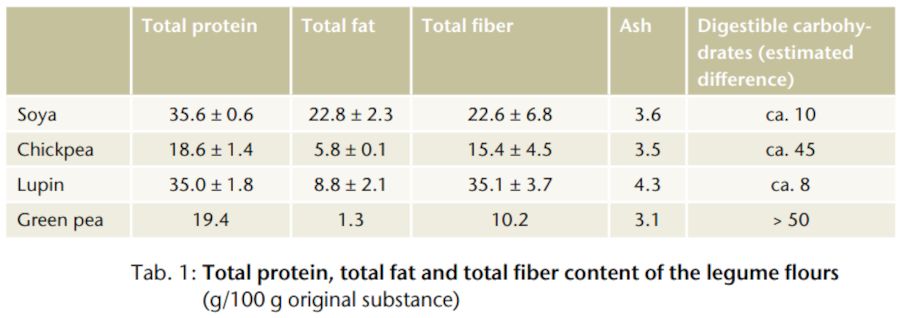
Lupin flour certainly boasts an impressive array of nutritional benefits, making it a valuable addition to a balanced diet. Let’s discuss its nutrient composition in more detail:
How many carbs in lupin flour?
Per 1/3 cup of lupin flour, the total amount of carbohydrates is 14 grams. In comparison, the same amount of wheat flour contains around 32 grams.
Choosing lupin flour over regular flour helps cut the consumption of total carbohydrates in more than half. But it gets better.
Most people following a keto or low-carb will be more interested in knowing how many net carbs are there in lupin flour. The net carbohydrates (total carbohydrates minus fiber) in 1/3 cup of lupin flour is only 2 grams.
As you can see, lupin flour is an extremely low-carb flour, making it suitable for those following low-carb or ketogenic diets.
Protein
Lupin flour is one the the most protein rich legumes, providing about 40 grams of protein per cup.
Lupin beans have more protein than peas or any other legumes, and its protein content of about 40 per cent dry matter is on par with that of soy beans.
The amino acid composition of lupins of extremely high quality for a plant based protein source. The table below shows the breakdown of the amino acid composition in white lupin seeds:
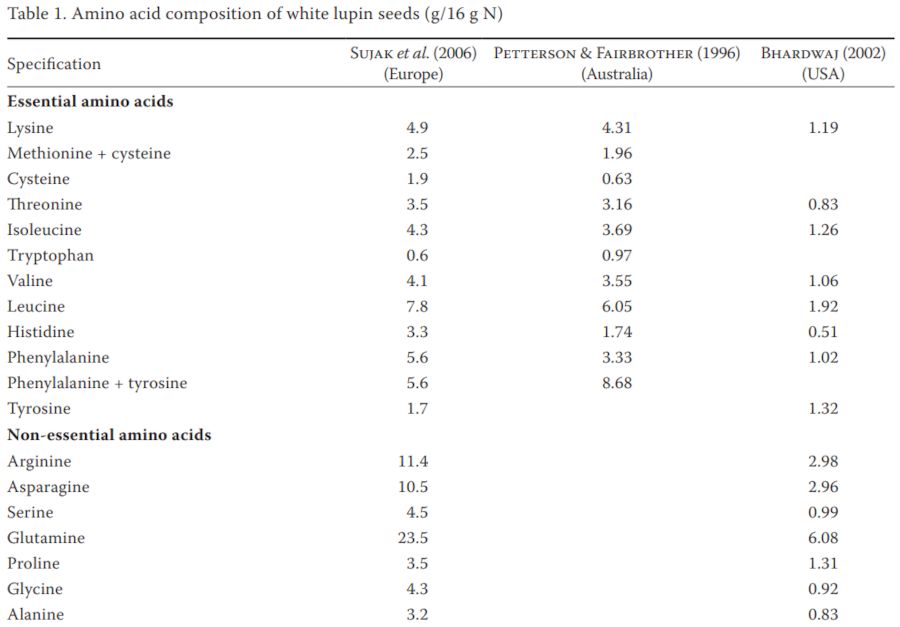
Lupin contains all the essential amino acids, which are amino acids that the human body cannot produce on its own and must be obtained through the diet. This complete amino acid profile is very rare in plants.
Having a complete set of essential amino acids is essential for overall health and maintaining proper bodily functions. They are crucial for protein synthesis, tissue repair, and the production of enzymes and hormones.
Fiber content
Lupin flour is a a valuable source of dietary fiber, mostly insoluble. It contains approximately 36 grams of fibers per 100 grams (3.5 ounces), or about 12 grams of fiber per 1/3 cup.
According to this study, lupin fiber has the highest fiber content among legume flours. Lupin flour also contains small fractions of easily soluble fibers which reduce postprandial glycaemia (the blood glucose levels after eating a meal).
Minerals
Lupin flour contains a variety of essential minerals like iron, calcium, magnesium, phosphorus, potassium, and zinc.
These minerals play crucial roles in various physiological processes, including bone health, nerve function, and energy metabolism.
The low levels of phytic acid in lupin enable enhanced mineral absorption in the body. Phytic acid, also known as phytate, can bind to minerals and reduce their absorption in the digestive system.
The tables below show the approximate amounts of minerals in lupin flour per 3.5 ounces (100 grams) and per 1/3 cup (33 grams):
| Minerals in Lupin Flour | 3.5 oz (100 g) | 1/3 cup (33 g) |
| Calcium, Ca | 91 mg | 30 mg |
| Iron, Fe | 3.94 mg | 1.3 mg |
| Magnesium (Mg) | 188 mg | 62 mg |
| Potassium, K | 970 mg | 320 mg |
| Selenium (Se) | 8.2 µg | 2.7 µg |
| Sodium, Na | 45 mg | 14.8 mg |
| Zinc (Zn) | 3.5 mg | 1.16 mg |
Vitamins
Lupin flour is also a modest source of vitamins, including several B-vitamins and anti-oxidants, specially tocopherol, a type of vitamin E.
The table below show the approximate amounts of vitamins in lupin flour per 3.5 ounces (100 grams) and per 1/3 cup (33 grams):
| Vitamins in Lupin Flour | 3.5 oz (100 g) | 1/3 cup (33 g) |
| Beta carotene | 200 µg | 66 µg |
| Lutein | 1.5 µg | 0.495 µg |
| Thiamin (B1) | 0.64 mg | 0.211 mg |
| Niacin (B3) | 2.2 mg | 0.73 mg |
| Folate, natural | 350 µg | 116 µg |
| Vitamin C | 2 mg | 1 mg |
| Gamma tocopherol | 20.3 mg | 6.7 mg |
| Vitamin E | 2.33 mg | 0.77 mg |
As you can see, lupin flour is a good source of several important vitamins and minerals. However, please keep in mind that the exact nutrient content can vary based on factors such as the variety of lupin used, brand and processing method.
Is lupin flour good for diabetics?
Lupin flour is a great source of protein and fiber, and it has a low glycemic index (GI) of only 15, and a glycemic load (GL) of 6.1.
This means that it does not cause a rapid rise in blood sugar levels after eating.
Researchers have shown that the protein γ-conglutin present in lupin has glucose-lowering effects beneficial for diabetics, and that the inclusion of lupin proteins in future antidiabetic formulations could be promising.

Is Lupin considered an allergen?
Yes, lupin flour can cause allergies, especially in individuals who are sensitive or allergic to legumes.
Lupin is a member of the legume family, which also includes peanuts, soybeans, and lentils. Therefore, people who are allergic to peanuts or other legumes may also be at risk of developing an allergy to lupin.
If you have a history of allergies, it is important to talk to your doctor before consuming lupin flour. They can help you determine if you are at risk for a lupin allergy.
Does lupin flour cause bloating?
Lupin flour can cause digestive upset in some people, such as bloating, gas, and diarrhea. This is because lupin flour contains a type of carbohydrate called galactomannan, which can be difficult to digest.
Most people experience no side effects from eating lupin flour or lupin beans, but the following groups are more likely to be sensitive to it:
- People sensitive to FODMAPs: Legumes like lupin, chickpeas and lentils contain oligosaccharides, a type of carbohydrate that can be difficult to digest for people who suffer from nonallergic food intolerance.
- People with irritable bowel syndrome (IBS): IBS is a condition that affects the large intestine. People with IBS may be more likely to experience bloating and other digestive problems after consuming lupin flour.
- People who are new to lupin flour, especially those not used to eating large amounts of fiber. In this case, it’s best to start with small portions and gradually increase the intake over time. This will help your body to adjust to the new food and reduce the chance of bloating.
If you experience discomfort and bloating after consuming lupin flour, it might be better to stop eating it. There are other low-carb and gluten-free flours that you can use instead, such as almond flour or coconut flour.
Does lupin flour go bad?
Although lupin flour can last a long time if stored properly (see below tips on how to store lupin flour), it can go bad sooner than expected. Here are some signs that lupin flour may have gone bad:
- The flour has a rancid odor.
- The flour has changed color.
- The flour has become lumpy or sticky.
If you notice any of these signs, it is best to discard the flour.
How to store it?
I love baking with lupin flour and always have several packages in my pantry. Here’s my tips on how to store lupin flour:
- Store it in an airtight container. This will help to keep the flour fresh and prevent it from absorbing moisture.
- Store it in a cool, dark place. This will help to prevent the flour from going rancid.
- Label the container with the date you opened it. This will help you to track how long the flour has been stored and determine if it is still safe to eat.
Lupin flour has a shelf life of about 18-24 months if stored properly. However, it is best to use it within 6 months of opening the container while it’s freshest.
If you don’t cook or bake very often, you might not finish your package of lupin flour in under 6 months. So here are some tips for extending the shelf life of lupin flour:
- Keep it refrigerated: The cool temperature will slow down the rate of spoilage.
- Freeze it: This will extend the shelf life of the flour for up to 2 years.
- Use it in cooking or baking recipes: The high heat will help to kill any bacteria that may be present in the flour.
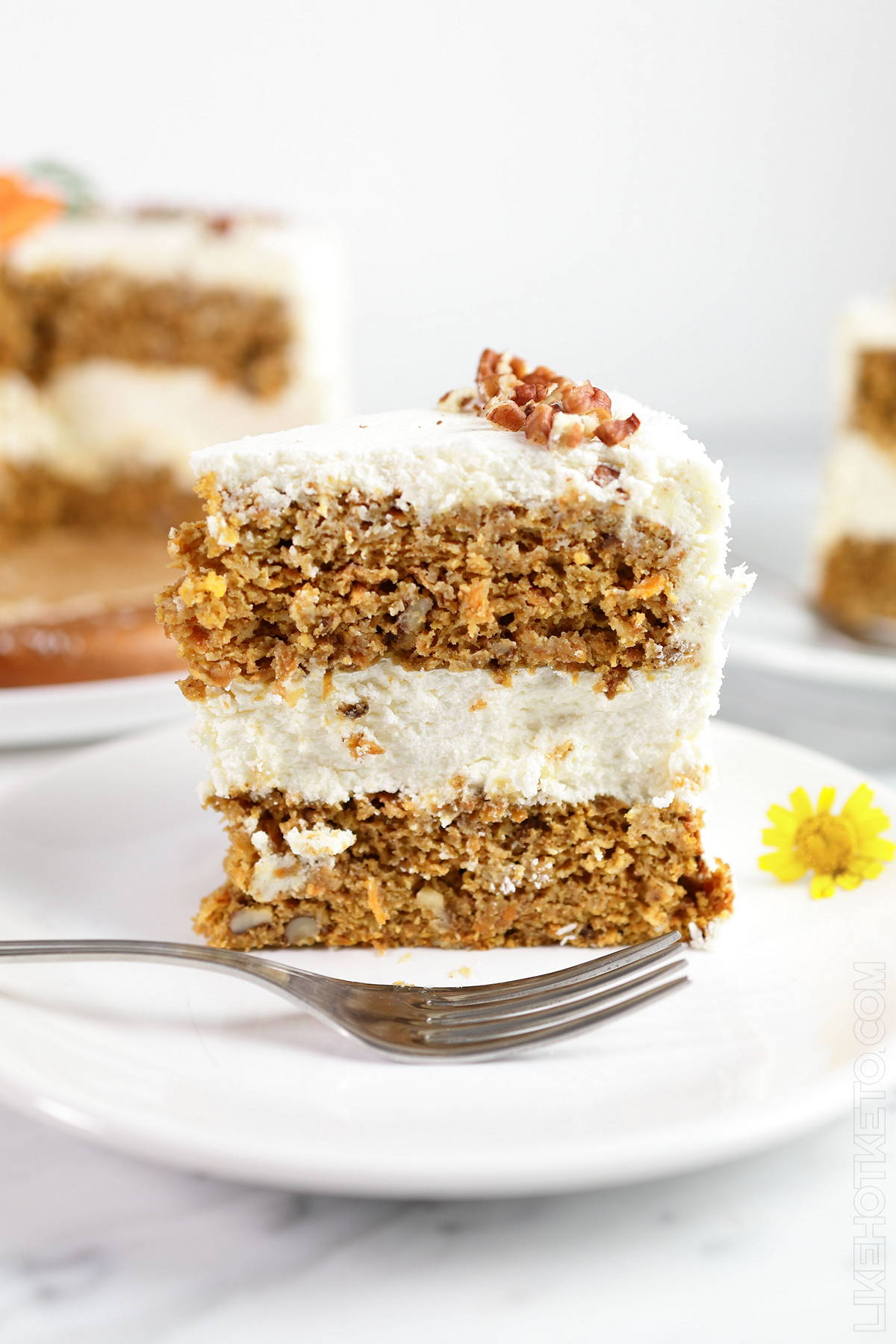
Where to find lupin flour
Lupin flour is becoming more popular and widely available in the US, especially in specialty food stores and health food shops.
Additionally, you may find it in some larger supermarkets or grocery stores, particularly those with a well-stocked gluten-free or health food section.
If you are having difficulty finding lupin flour locally, here are some other places where you might be able to purchase it:
- Online Retailers: Many online retailers and e-commerce platforms offer a variety of gluten-free and specialty flours, including lupin flour. Websites like Amazon, Thrive Market and iHerb often have a selection of lupin flour available for purchase.
- Health Food Stores: Specialty health food stores, organic food stores, or stores that cater to specific dietary needs are more likely to carry lupin flour.
- Co-ops and Farmers’ Markets: Some farmers’ markets and food co-ops may offer lupin flour as part of their selection of locally sourced and specialty products.
- Direct from Manufacturers: You can also check the websites of manufacturers that produce lupin-based products. Some companies sell their products online or provide information on where their products are available for purchase.
As the availability of products may change over time, I recommend checking with your local retailers and exploring online options to find the best sources for lupin flour in your area.
Other names for lupin flour
When shopping for lupin flour, you might see some name variations that can be confusing. For example, the cleverly named Miracle Flour All-Purpose. This is just a regular lupin flour made of 100% sweet lupin beans!
So if you’re asking yourself, Is this the right one to buy? It probably is. Lupin flour may also be known by the following names:
- Lupini Flour: Lupini is a variation of the term lupin and is often used interchangeably.
- Lupine Flour: This is another spelling variant of lupin flour.
- Lupinus Flour: Lupinus is the botanical genus name for lupin plants, and the term is sometimes used in place of lupin.
- Yellow Lupin Flour: Some lupin flour varieties are made specifically from yellow lupin seeds (from the species Lupinus luteus), and this name may be used to specify the type.
- Blue Lupin Flour: Similar to the previous point, this term may be used to refer to lupin flour made from blue lupin seeds (from the species Lupinus angustifolius).
- Sweet Lupin Flour: “Sweet lupin” is a variety of lupin with lower alkaloid levels, resulting in a milder taste, and the flour made from this type may be referred to as sweet lupin flour.
It’s worth noting that regional variations and different manufacturers may use different names for lupin flour, so if you’re looking for a specific type or brand, it’s a good idea to check the product label or contact the manufacturer directly.
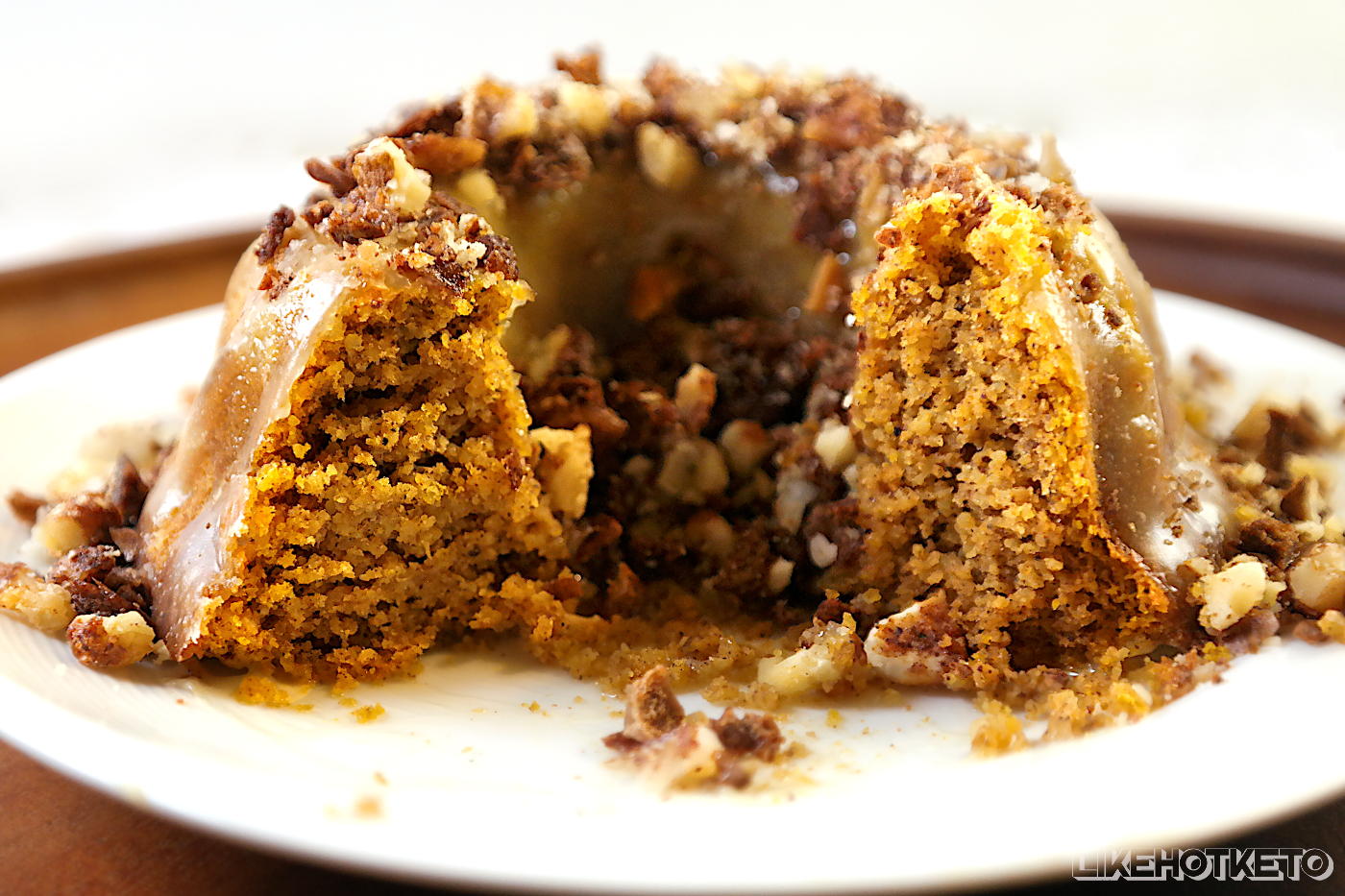
Must-try lupin flour based ingredients
There are several keto-friendly lupin flour based products (besides lupin flour) that you can experiment with to add some variety to your keto or low-carb diet. Here are some of my favorites:
Lupin flakes
Touted as the keto “oats”, these lupini flakes are a good substitute for morning cereal on keto. They are full of fiber and high in protein, making them the ideal breakfast to keep you full for hours!
Lupin flakes can be used as a substitute for oats in baking recipes, and they will provide a similar texture to the final baked goods. This can be useful for those who are looking for gluten-free or low-carb alternatives to oats.
Lupini rice
Definitely try this if you miss eating rice on keto. This lupini rice reminds me of Arborio rice (the type used for risotto), and its texture can be more like rice or orzo depending on how long you cook it.
Lupin flour based rice is a much better substitute for rice on keto than cauliflower or shirataki (Miracle rice)!
Ground lupin beans
You can use these ground lupin beans in keto and low-carb recipes as a substitute for couscous, quinoa or bulgur wheat, for example.
Just to clarify, ground lupin beans are different from lupin flour.
Although lupin flour is also made of ground lupin beans, this version is more roughly milled, so it doesn’t turn into a fine flour that can be used for baking.
Lupin pasta
This keto lupini pasta will definitely satisfy your cravings! It’s the best low-carb pasta I’ve tried, and it has only 3 net carbs and a whopping 20 grams of protein per serving!
You know how much I love keto hearts of palm pasta, but I must admit that lupini pasta’s texture is much more similar to the real deal.
How to bake with lupin flour?
Lupin flour is incredibly easy to work with. You can just swap the whole amount of wheat flour in a recipe for lupin flour, at a 1:1 ratio. But this is not recommended in all types of recipes.
The nutty taste of lupin flour is easily masked when other flavorful ingredients like cocoa powder or peanut butter are present in the recipe – such as my lupin flour monster cookies or these chocolate cupcakes with lupin flour.
However, when used by itself with no other contrasting flavors lupin flour can lend an overpowering nutty, even beany flavor to your baked goods.
For this reason, you should avoid using 100% lupin flour in recipes with more delicate or buttery flavors, like chocolate chip cookies or vanilla cake.
For these types of recipes, mixing lupin flour with another low-carb and gluten-free flour like coconut or almond flour is the best way to enjoy the benefits of lupin flour without compromising on flavor.

How does lupin flour compare to other keto flours?
Lupin flour vs almond flour
Although they have some similarities, lupin flour and almond flour also have distinct differences in terms of taste, texture, nutrition and behaviors in baking. Let’s compare them and see which is best:
- Taste and Texture:
- Lupin Flour: Lupin flour has a mild, slightly nutty flavor that can be slightly bitter. It has a fine texture, similar to traditional wheat flour, making it suitable for a wide range of baked goods.
- Almond Flour: Almond flour has a distinct nutty taste with a hint of sweetness and a slightly grainy texture. It adds moisture and a rich flavor to baked goods.
- Nutritional Content:
- Lupin Flour: Lupin flour is high in protein and dietary fiber, making it a nutritious option for those seeking more protein in their diet. It is rich in vitamins and minerals, including magnesium, iron, and zinc.
- Almond Flour: Almond flour is also a good source of protein and dietary fiber. It is higher in fat compared to lupin flour, with most of the fat being healthy monounsaturated fats. Almond flour is a good source of vitamin E and magnesium.
- Carbohydrate Content:
- Lupin Flour: Lupin flour is lower in carbohydrates than almond flour, making it a preferred choice for those following low-carb or keto diets.
- Almond Flour: While almond flour is lower in carbohydrates compared to wheat flour, it is higher in carbs compared to lupin flour.
- Baking Applications:
- Lupin Flour: Lupin flour is a good binder, which means that it can help to hold your baked goods together. It is also denser than almond flour, which means that it can make your baked goods more chewy – perfect for cookies!
- Almond Flour: Almond flour is lighter than lupin flour, which means that it can make your baked goods more delicate. Almond flour is also a good source of fat, which can make your baked goods moister.
When substituting them in recipes, it’s essential to consider their different textures and moisture-absorbing properties to achieve the desired results.
Due to its denser quality with less fat content, you need more liquid in recipes that take lupin flour compared to those with almond flour.
The following table shows a comparison of lupin flour and almond flour nutrition facts per 100 grams (3.5 ounces):
| Nutrient | Lupin Flour | Almond Flour |
|---|---|---|
| Calories | 333 kcal | 571 kcal |
| Fat | 6.06 g | 53.6 g |
| Protein | 39.4 g | 28.6 g |
| Total carbohydrates | 42.4 g | 35.7 g |
| Fiber | 36.4 g | 7.1 g |
| Net carbs (Total-Fiber) | 7.8 g | 28.6 g |
All in all, lupin flour is the best choice for most low-carb baking applications. Except for light and airy or delicate tasting baked goods, like macarons or angel food cakes – recipes like these will have better results with almond flour.
Lupin flour has a finer texture, making it easier to substitute for all-purpose flour. It contains about half the calories of almond flour, significantly more protein, and almost no phytic acid. To top it off, lupin flour is a more budget-friendly option.
Lupin flour vs coconut flour
- Taste and Texture:
- Lupin Flour: Lupin flour has a mild nutty flavor, and it has a fine texture similar to traditional wheat flour.
- Coconut Flour: Coconut flour has a distinct coconut flavor and a dense, fibrous texture. It adds a subtle coconut taste to recipes and requires more moisture in baking due to its high absorbency.
- Nutritional Content:
- Lupin Flour: Lupin flour is exceptionally nutritious, being high in protein and dietary fiber. It is an excellent source of vitamins and minerals, including iron, potassium, and magnesium.
- Coconut Flour: Coconut flour is also rich in dietary fiber and contains healthy fats. It is lower in protein compared to lupin flour.
- Carbohydrate Content:
- Lupin Flour: Lupin flour is lower in carbohydrates compared to coconut flour, making it a preferable choice for those following low-carb or keto diets.
- Coconut Flour: While coconut flour is gluten-free and grain-free, it is higher in carbohydrates, which can affect blood sugar levels.
- Allergen Considerations:
- Lupin Flour: Lupin flour is a legume, and individuals with peanut or legume allergies should exercise caution when using lupin products.
- Coconut Flour: Coconut flour is nut-free and suitable for those with nut allergies, making it a safer alternative for those with nut sensitivities.
The following table shows a comparison of coconut flour and almond flour nutrition facts per 100 grams (3.5 ounces):
| Nutrient | Lupin Flour | Coconut Flour |
|---|---|---|
| Calories | 333 kcal | 424 kcal |
| Fat | 6.06 g | 15.3 g |
| Protein | 39.4 g | 16.1 g |
| Total carbohydrates | 42.4 g | 58.9 g |
| Fiber | 36.4 g | 34.2 g |
| Net carbs (Total-Fiber) | 7.8 g | 24.7 g |
There’s a couple more details to keep in mind when choosing between lupin flour and coconut flour:
Coconut flour is cheaper than lupin flour (usually). However, recipes with coconut flour need larger amounts of eggs and butter to turn out moist. This increases the overall expense of making the recipe, reducing the initial economic advantage of using coconut flour.
Lupin flour is easier to work with. It can replace wheat flour at a 1:1 proportion without changing the liquids in the recipe. On the other hand, coconut flour needs to be reduced at about 1/3 of the original volume of flour in the recipe.
As you can see, both lupin flour and coconut flour have their advantages and can be valuable additions to a gluten-free and grain-free diet.
Consider the nutritional profile and baking properties of each flour to determine which one best fits your dietary needs and culinary preferences.
While lupin flour is a great option for low-carb and high-protein baking, coconut flour’s unique taste and texture make it suitable for a variety of gluten-free recipes.
Recipes with lupin flour
I bet you can’t wait to try your hand at some easy keto and gluten-free recipes developed especially for lupin flour!
If you ever looked for lupin flour recipes online, you probably didn’t have much luck finding recipes made with lupin flour as the sole flour ingredient, without adding almond flour or coconut flour, or other combinations.
That’s because although it’s easy to substitute lupin flour in recipes texture-wise, it can be difficult to find the right balance for the nutty flavor.
I just love baking with lupin flour, and have developed some great recipes that use lupin flour as the standalone flour! I also have a few recipes with lupin flour in combination with other keto and glute-free flours. Check these out:
Lupin flour waffles – A simple lupin flour recipe to get you started! These are high protein savory waffles which are tasty by themselves or you can add different toppings and call it a meal, as they are very nutrient-dense!
Lupin flour monster cookies – Fun chewy cookies made exclusively with lupin flour!
Lupin flour carrot cake – Also a lupin flour only recipe! This keto and gluten-free layer cake with cream cheese buttercream frosting is my favorite cake recipe to date!
Pumpkin mini bundt cakes – These lovely mini cakes with pumpkin puree are soft and buttery, and lupin flour is the only flour in them!
Protein chocolate cupcakes – These moist and decadent cupcakes with peanut butter frosting take a combination of lupin flour, flax meal and whey protein powder.
Time to get baking!
I hope I could answer all you ever wanted to know about lupin flour in this guide! I tried to be as comprehensive as possible.
While researching I fell down on some rabbit-holes of information (as usual) that I decided to leave out of this guide because they were not relevant to cooking. Like, did you know lupin is used to make biodegradable plastic? Me neither. Then after I read everything about it, I decide not to mention it because it ‘s probably not what you are looking for, dear reader. Anyway.
I believe I did include everything you needed to know to successfully start using lupin flour in your keto, low-carb and gluten-free recipes.
I would love to hear what YOU think about lupin flour: is it also your new favorite keto flour? And if there’s anything else you’d like me to include in this guide, please let me know in the comments below!

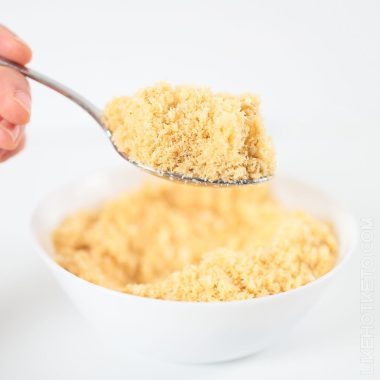




Hi Sandy. If by incorporate you mean replacing a portion of the almond or coconut flours without other changes to the recipe, lupin flour absorbs liquid in a very similar way to almond flour, although it’s drier (less fat). So it’s nearly the same as defatted almond flour, if you’ve tried that. You can replace it for almond flour in a 1:1 proportion. So, for example, if a recipe calls for 100 grams of almond flour, you could instead use 70 grams of almond and 30 grams of lupin, or 50 grams of almond and 50 grams of lupin. Never replace more than 50% of almond flour in a recipe for lupin, though, as the taste is very different and the texture would also change too much. Don’t try replacing almond in recipes that have a delicate taste, like sugar cookies or vanilla cakes, because they will end up tasting bitter and beany. If you are just starting to experiment with lupin flour, I suggest you try some recipes developed using lupin flour (I have several, and more coming up!) so you can get an idea of how it tastes and behaves in terms of texture so you can be more confident when implementing it in different recipes. Good luck!
How do I incorporate lupin flour into my almond flour and coconut flour recipes?